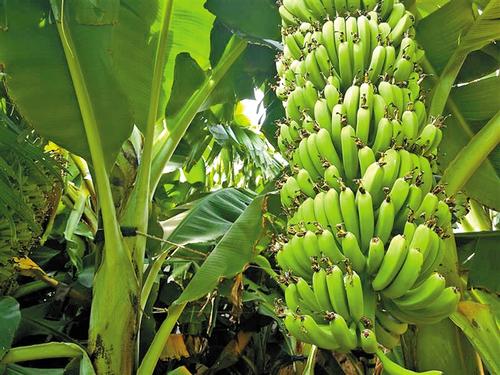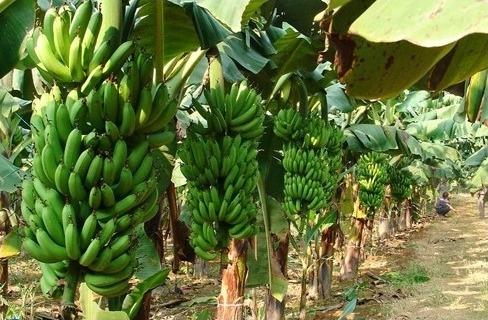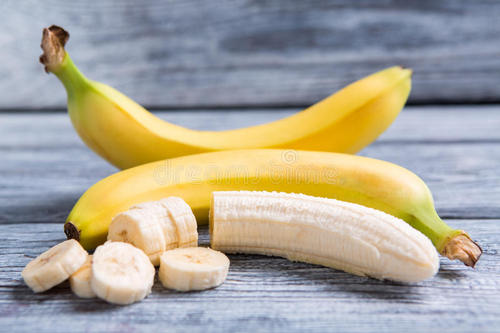Banana Profile
Written by lisa
Nov 09 2020

Banana Picture


Banana morphological characteristics
Banana plants grow in clusters and have stolons. The short type is less than 3.5 meters in height, generally, less than 2 meters in height and the tall type is 4 to 5 meters in height. The pseudostems are dark green with black spots and are white powdered, especially the upper part.Banana leaves are oblong, 2 to 2.2 meters long, 60 to 70 cm wide, blunt apex, near the round base, symmetrical on both sides, dark green on the leaf surface, no white powder, light green on the back of the leaf, white powdered. The petiole is stubby, usually, less than 30 cm in length and the leaf wings are prominent, open, and the edges are maroon or bright red. The spikes are drooping, the inflorescence axis of the banana is densely covered with brown hairs, the outer bracts are purple-red, white powder, the inner surface is dark red, but the base is slightly light, shiny, and the male flower bracts do not fall off. There are 2 flowers in each bract Column. The flower of banana is milky white or light purple, the free tepals are nearly round, and the whole tepal has a sharp cone-shaped tip. The middle two side lobes of the connate tepals are long, about 1/2 of the central lobes.
The largest banana cluster has 360 fruits and weighs up to 32 kilograms. The general fruit cluster has 8 to 10 fruits and about 150 to 200 fruits. The body of the banana is curved and slightly arched. The young fruit of the banana is upward and upright. After maturity, it gradually becomes flat. It is 12 to 30 cm long and 3.4 to 3.8 cm in diameter. The banana fruit has obvious edges, with 4 to 5 edges, and the apex is tapered, not significantly reduced. The stalk is short, the peel of the banana is bluish-green, ripening at high temperature, the peel is greenish and yellowish, at low temperature, the peel turns from green to yellow, and the raw tingle black spots, the flesh is soft, yellow-white, and taste Sweet, seedless, and strong fragrance.
Banana growth habit and growing environment and distribution
Bananas like hot and humid climates and thrive in deep soil, loose soil and good drainage. Irrigation cultivation has also been successful in semi-arid areas like southern Jamaica. Wild bananas are cultivated by seeds, and artificial bananas can be cultivated by sucking roots and pseudo-bulb ramets; the first harvest takes 10 to 15 months, and the harvest is almost continuous thereafter.
Banana roots are delicate, and the selection of soil is strict. Poorly ventilated clay and heavy soil or poor drainage are extremely unfavorable to the development of the root system. Sandy loam soil with a clay content of less than 40% and a groundwater level below 1 meter. Especially alluvial loam or humus loam is suitable. The practice has proved that if the physical properties of the soil are not good, it is difficult to promote the normal growth of bananas even if the fertilizer and water supply is sufficient. The pH value of the soil is between 4.5 and 7.5, and 6.0 is the best because the fusarium in the soil below 5.5 multiplies rapidly and blight is easy to invade. Although bananas are not very sensitive in a saline environment, it is not suitable if the soil contains exchangeable sodium ions over 300mg/L. The most suitable rainfall is 100 millimeters per month, and the dry season is less than 50 millimeters. Due to lack of water, bananas have a prolonged budding period, short fruit fingers and low yield. For example, if the banana orchard is flooded or flooded, the leaves will turn yellow in the lighter ones, which can easily induce leaf spot epilepsy, and the yield will be greatly reduced.
The average distribution area of bananas is above 21℃ for many years, and a few are about 20℃. Bananas require high temperatures and humidity. The growth temperature is 20~35℃, the most suitable is 24~32℃, and the lowest should not be lower than 15.5℃. Bananas are afraid of low temperatures and avoid frost and snow, and their cold resistance is weaker than plantains and pink bananas.
The critical temperature at which growth is inhibited is 10°C. When it drops to 5°C, the leaves become yellow due to chilling damage, and the leaves die at 1 to 2°C. The fruit is chilled at 12°C, and the skin color will be grayish-yellow after ripening, which will affect the commodity value.

China is one of the ancient countries in the world to cultivate bananas, and most of the main banana varieties in the world are passed down from China. Bananas are distributed in tropical and subtropical areas within 30° of north-south latitude in the eastern, western and southern hemispheres. There are 130 countries in the world that cultivate bananas, with Central America producing the most, followed by Asia. Chinese bananas are mainly distributed in Guangdong, Guangxi, Fujian, Taiwan, Yunnan and Hainan, and a small amount of cultivation is also found in Guizhou, Sichuan and Chongqing.
The world’s main production bases include Costa Rica, Honduras, Guatemala, Mexico, Panama, Dominican Republic, Guadeloupe, Jamaica and Martinique in Central America and the West Indies, Brazil, Colombia and Ecuador in South America. Tropical countries such as Canary Islands, Ethiopia, Cameroon, Guinea and Nigeria in Africa, India, Thailand, and the Philippines have large-scale cultivation. China's Taiwan Island, Hainan Island, southern Fujian, Caojiang in Gaozhou.
Banana efficacy and role
Bananas are high-calorie fruits, and bananas are also used as the main food in some tropical regions. Banana pulp has a high nutritional value. In addition, it also contains a variety of trace elements and vitamins. Among them, vitamin A can promote growth and enhance resistance to diseases, which is necessary to maintain normal fertility and vision; thiamine can resist beriberi, promote appetite, aid digestion, and protect the nervous system. Riboflavin can promote the normal growth and development of the human body. In addition to stabilizing serotonin and melatonin, bananas also contain magnesium, which can relax muscles. Those who are often under pressure can eat more. Banana cultivation Tuber reproductionTuber propagation is mainly a propagation method used to cultivate a large number of banana sprouts in a short period of time. Use unflowered plants or underground stems that suck buds as materials. The best cutting time is from November to January of the following year. Most of them can germinate. The seedlings can be planted in April, May, and June with a height of 40-50 cm. The advantage of this propagation method is that it can reduce banana diseases and insect pests. It has a high survival rate, regular growth, and regular results. The initial plants are shorter than the sucking buds and are more wind-resistant, but have the disadvantage of low yield in the first generation.
The method of cutting the underground stems to propagate is to cut off the underground plants, dig up the tubers, leave the pseudostems 12-15 cm high, and then cut the banana tubers into small pieces, each weighing more than 120 grams, with a thick one on top Bud eyes, the cut surface is coated with plant ash for preservation. Next, place the cut pieces flat on the borders according to the row spacing of 15 cm, with the banana bud eyes facing up, and then cover with soil and grass for fertilization management. One week before the sprouts come out of the nursery, the same amount of Bordeaux mixture should be sprayed twice to prevent leaf spot. If a bunch of top disease seedling is found, it should be removed in time, and lime should be used for disinfection to prevent infection. Ram propagationThe conventional propagation of bananas mainly uses bud sucking for branch propagation. When the sucking bud grows to more than 40 cm, it can be divided into plants and reserved as mother plants for the next generation or as seedlings. When dividing the plant, dig up the soil next to the sucking bud first, and then use a shovel to cut between the mother plant and the sucking bud. After the seedlings are dug out, cut off the long and injured roots, dry the cuts in the shade or smear them with plant ash, and then plant them.
Latest Updated
- Benefits of Bugleweed - 7 Science-backed Health Benefits
- Bugleweed Dangers & Side Effects - Is It Poisonous?
- How to Plant Evergreen Trees - What You Should Know
- When to Plant Evergreens - Grow Guide for Evergreen Trees
- 12 Wonderful Evergreen Shrubs for Your Garden
- 12 Popular Evergreen Plants with Pictures for Beginners
- When And How To Prune A Lilac Bush Like a Pro
- How to Grow & Care for Lilac Vine (Hardenbergia Violacea)
- Japanese Lilac Tree (Syringa Reticulata) Care & Propagation Guide
- Shumard Oak Pros and Cons - What to Know
Popular Articles
- Winter maintenance of Antirrhinum Majus
- How to Grow Terminalia Mantaly Tree
- How to Grow and Care for Crossostephium Chinense
- How to grow Antirrhinum Majus in spring
- Peristeria Elata (Dove Orchid) Profile: Info & Care Guide
- Underwatered Snake Plant (Sansevieria Trifasciata) - Signs And How To Fix
- How to Care for Brazilian Jasmine Plant (Mandevilla Sanderi)
- How to Grow & Care for Graptopetalum Purple Delight in Summer
- Rosa Chinensis (China Rose): Plant Growing & Care Tips
- How to Care for Baby Sun Rose (Aptenia Cordifolia)